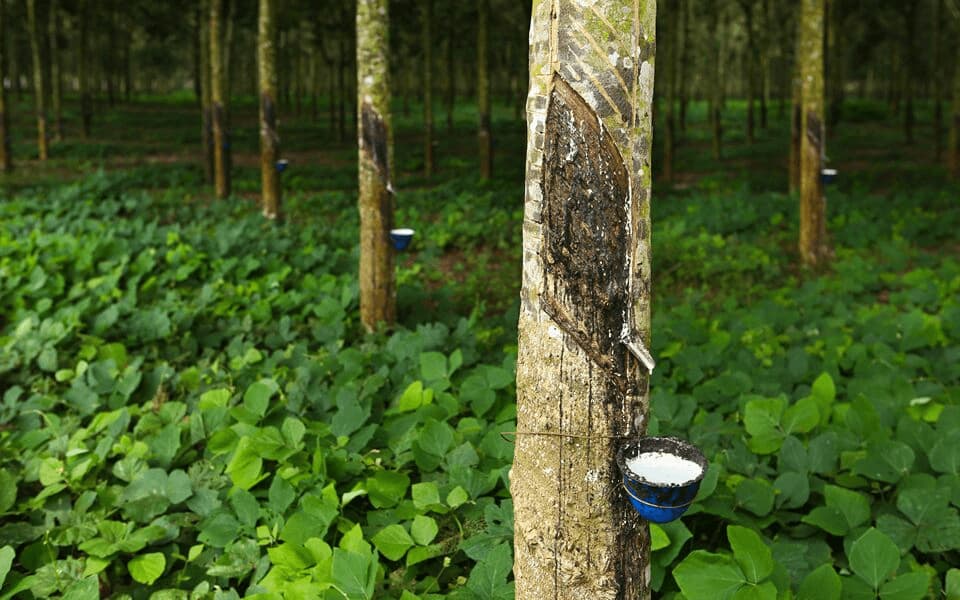The first synthetic rubber was created in Germany in 1909, and as rubber costs skyrocketed, later versions were employed in both World War I and succeeding years. Finally, synthetic rubber usage entered the mainstream in World War II. This increased usage was directly due to the enormous demand for rubber needed to make tires for war machines and the prohibitively expensive and insufficient supply of natural rubber.
The main method for obtaining natural rubber is tapping rubber trees, which release latex, a sticky material resembling milk. The latex is collected, then processed to create rubber. Natural rubber can either be vulcanizedor left uncured. Rubber is heated during the vulcanization process, after which peroxide, bisphenol, or sulfur may be added to change its flexibility, strength, or resistance to stresses.
Vulcanized rubber has more uses than other ones. Shoe soles, hockey pucks, domestic clothes wringers, rubber boots, and pump housings are a few items that rubber producers create utilizing vulcanized rubber. In addition, they produce adhesives, insulation, cement, friction tapes, and crepe rubber, which is used to insulate clothing and footwear using uncured rubber.
Rubber's relative gas impermeability is another fantastic quality that makes it a popular material for making things like balloons, air hoses, sports balls, and cushions. Additionally, as soft rubber products have a high level of electrical resistance, they are frequently employed inside protective footwear like gloves and shoes. The fabrication of electrical instruments, such as components for radio sets, meters, and telephone housings, uses hard rubber just as frequently.
Rubber producers frequently employ rubber to create diving equipment, rain boots, rain jackets, umbrellas, medical and chemical tubing, and the lining of railroad tank cars, storage tanks, and processing equipment since it is water and fluid resistant. Large and small gaskets, latex gloves, shock absorbers, and specialty equipment mounts are examples of other rubber items. Even extrusion, rubber bonding, and rubber molding operations can utilize rubber.
An interested party will approach a rubber producer with knowledge and willingness to hear customer requirements for the greatest outcomes. When discussing its application, customers should communicate to rubber manufacturers the amounts of stress and strain they want to place on their product and the temperature range in which it will operate.
The required strength and, to some extent, the rubber product's elasticity will depend on the anticipated levels of stress and strain. Additionally, because elasticity changes with temperature, and a manufacturer must design a product to account for that, it is crucial to indicate projected temperature averages.
Rubber items are made via a technique called rubber extrusion. The procedure involves applying high pressure to an extrusion machine to push synthetic or natural rubber material through a formed die. Typically, rubber that has not been vulcanized and is soft is used. First, the workpiece is shaped while it is soft and malleable, and then it is vulcanized to harden it into a usable finished product.
Two basic pieces make up a rubber extruder machine. Compounds are supplied into the extruder as the raw material is pushed along a conveyor by a heated shearing screw. The material is heated and softened to make it flexible as it passes along the conveyor. The shearing screw applies pressure to the softened material, forcing it into the die, where it is given its final shape.
The rubber material is fed through horizontal rollers inside calendering machines. Frequently, they are employed in the rubber friction or combining process, which involves fusing rubber sheeting with another material or fabric.
Without the rubber tires on modern vehicles, driving would be challenging. In addition, numerous other items would disappear, including rubber boots, flooring, surgical gloves, and balloons for kids' parties. The ability to benefit from a strong, long-lasting, and wonderful material is undoubtedly why rubber manufacturing is so well-liked today. Rubber manufacturing is environmentally friendly, which is another benefit. Many things harm the environment in the modern world.
Non-biodegradable materials, like tin and plastic, are dumped in rivers and oceans, tainting their crystal-clear freshness and seriously harming the environment. However, rubber is a wonderful material that doesn't harm the environment. While the world is unquestionably getting increasingly polluted and uninhabitable every year due to the manufacturing of other products, rubber manufacturing is very common in the modern world because rubber is harmless and biodegradable. People can make a variety of goods with the material produced by the rubber industry.

As China's top rubber and plastic product manufacturer, Kingtom has been committed to producing high-quality automotive rubber parts, airport baggage carousel, and racecourse rubber mats for global users. Welcome to visit us at any time.